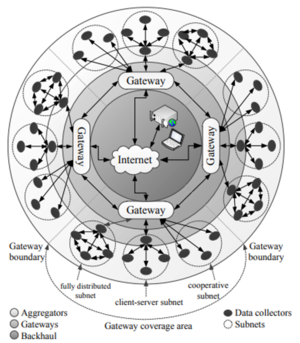Machine-to-Machine (M2M)
Machine-to-Machine (M2M) communication is a form of data communication that involves one or more entities that do not necessarily require human interaction or intervention in the process of communication. M2M is also named as Machine Type Communication (MTC) in 3GPP. It is different from the current communication models in the ways that it involves:
- new or different market scenarios
- lower costs and effort
- a potentially very large number of communicating terminals
- little traffic per terminal, in general
M2M communication could be carried over mobile networks (e.g. GSM-GPRS, CDMA EVDO networks). In the M2M communication, the role of mobile network is largely confined to serve as a transport network. With a potential market of probably 50 million connected devices, M2M offers tremendous opportunities as well as unique challenges. These devices vary from highly-mobile vehicles communicating in real-time, to immobile meter-reading appliances that send small amounts of data sporadically.[1]
Machine-to-Machine (M2M) Communication Architecture[2]
A generic M2M communication architecture is shown in Figure 1. To support the high number of M2M devices (billions to trillions) that are expected to be part of an M2M network, hierarchical communication architectures have been proposed. At the highest level, the goal of M2M architectures is to aggregate information from data collectors, and to apply some decision-making function to this information to produce decisions which are then executed. Several data collectors (e.g. temperature sensors, location sensors or heart rate monitors) are used to collect information from multiple locations. Data collectors gather data in areas that are small compared to the total area covered by the M2M architecture. The data collectors are usually separated in physical space and can collect information from various types of sources. For example, one data collector could record the ambient temperature in one location, and another could record the current consumed by a television set in another distant physical location.
Figure 1. Generic M2M communication architecture

source: KSII
In M2M architectures, data collectors of the same type are connected to small networks (e.g. Body Area Networks (BANs), Zigbee, and Bluetooth), called subnets. Each subnet uses a network technology appropriate for the type of information to be collected and distributed. The network technology which is employed determines the subnet architecture. Three types of subnets (fully distributed, client-server and cooperative) are shown in Figure 1. In a fully distributed network, all nodes (e.g. various computers on a home Wi-Fi network) are connected as peers and share data amongst themselves. One of the nodes (e.g. a router’s Wi-Fi module) acts as a super-peer that has the ability to connect through some gateway (e.g. a router’s ADSL connection) to the Internet. In a client-server network, all clients onlycommunicate with the server; an example would be portable media players connecting to a media server. The server then relays appropriate information to other clients (e.g. wireless speakers). The server also has the ability to connect to the Internet through some gateway (e.g. a home router). A cooperative network is not, strictly speaking, a subnet. None of the nodes
(e.g. BAN sensors) communicate directly with each other as is the case on a subnet, but rather via the gateway (e.g. a cellular phone).
The collected data is then aggregated at possibly multiple layers of aggregation points. The number of aggregation layers depends on the expected number of M2M devices and how these devices are logically grouped. At each aggregation layer, data from multiple data collectors can be aggregated by applying some intelligence to the data. This means that the aggregation function is not merely assembling the data, but it can also reduce the amount of data retransmitted. This can be achieved, for example, through filtering data based on relevance, or by extracting higher-level information from aggregated data. Data aggregation is used to allow M2M devices to have low cost, consume little power and have a limited operating area. This is required to enable a system of billions to trillions of these devices.
Multiple local subnets using different communication standards can communicate with each other using some gateway which provides Internet connectivity or a similar backhaul network. The gateway typically interfaces with at least one device on each subnet to which it is connected, and is also connected to other gateways. An end-user can connect to a server to access information collected from the M2M data collectors. This server may be connected to the Internet or some other backhaul network. The function of the M2M server is to perform final processing tasks on the collected data, to store the data, log the transactions that occurred and to make the data available online to the various users of the M2M system.
- ↑ Definition - What does Machine-to-Machine (M2M) mean? TEC India
- ↑ M2M Communication Architecture M.J. Booysen, J.S. Gilmore, S. Zeadally, and G.-J.van Rooyen
